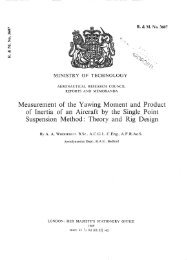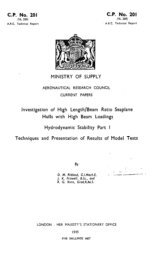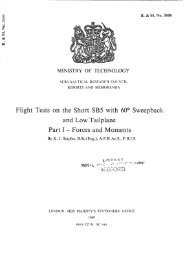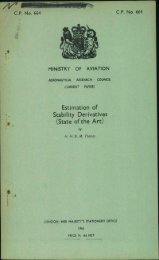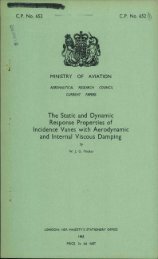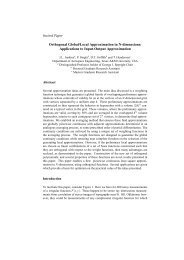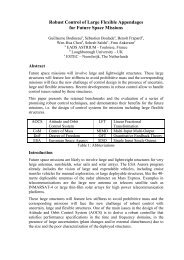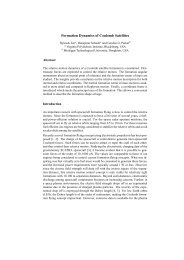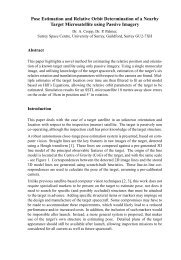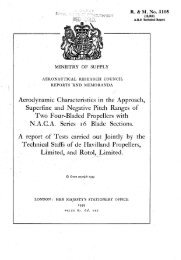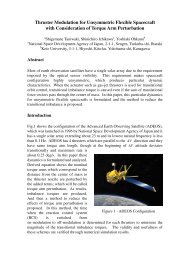The Aerodynamic Characteristics of Flaps
The Aerodynamic Characteristics of Flaps
The Aerodynamic Characteristics of Flaps
Create successful ePaper yourself
Turn your PDF publications into a flip-book with our unique Google optimized e-Paper software.
<strong>The</strong> increment A CL' is then<br />
F(6)<br />
A CL' : CL' -- C~ F (A)<br />
F(6) [crC - CLw]<br />
--F(A) g "<br />
CL~ is the lift coefficient <strong>of</strong> the plain wing at aspect ratio A.<br />
<strong>The</strong> increment A CL is given by<br />
and hence A CL ---- CL- Cz~,<br />
ACz' --F(A) ~' -- "<br />
(2)<br />
c' F(A) / c' \<br />
It follows that if we can develop a general process for predicting A CL' we should then be able<br />
to determine A CL for the general case <strong>of</strong> an extending chord flap on a wing <strong>of</strong> any aspect ratio.*<br />
It may be noted that, unlike A CL', A CL is dependent on incidence for a flap that extends<br />
or reduces the chord, since part <strong>of</strong> A CL is due to the effective change <strong>of</strong> chord and is proportional<br />
to wing incidence (i.e., the term containing CL~ in equation (6)). From equation (6)<br />
/<br />
d--~(ACr) = a~ -- 1 , .. . . . . . . . . . . (7)<br />
where a~ is the lift-curve slope <strong>of</strong> the wing alone. It follows that<br />
C'<br />
a = aw-, . . . . . . . . . . . . . . . . . . (8)<br />
6<br />
where a is the lift-curve slope <strong>of</strong> the wing plus flap.<br />
3.5.1.2. Part-span flaps.--Our usual problem is to derive A CL for a part-span flap given A CL'<br />
for a full-span flap. <strong>The</strong> simplest procedure is first to derive A CL as if the flaps were full-span and<br />
then to apply a factor for converting the lift increment to that for part-span flaps. This factor,<br />
which is discussed in rather more detail in section 4.1.2, is here denoted by A~(b/b), where b I<br />
is the flap span and b is the wing span. It is represented for various taper ratios by the curves <strong>of</strong><br />
Fig. 9. <strong>The</strong>se curves are based on theory 16, 4 checked with experimental results.<br />
We have then<br />
ACz (part-span flaps) = ~3(b/b) ACL (full-span flaps) . . . . . (9)<br />
3.5.2. P#ching moment imrements.--3.5.2.1. Full-span flaps (rectangular wing).--Taking<br />
moments about the extended chord quarter-chord point and reducing the moments to coefficient<br />
form in terms <strong>of</strong> the extended chord, we easily find that<br />
C,,' = C,, +-~ 1-- c-" " . . . . . . . . .<br />
where C,, and CL are the pitching moment coefficients and lift coefficients referred to the basic<br />
wing chord and quarter-chord point.<br />
But A C,.'= C~ 'l C~[,<br />
where C~ : C~ <strong>of</strong> the wing with flap retracted.<br />
* Strictly, account should have been taken in the above <strong>of</strong> the change <strong>of</strong> effective aspect ratio with the operation<br />
<strong>of</strong> a flap that extends the chord. <strong>The</strong> effect is, however, generally small, and in the analysis <strong>of</strong> a considerable amount <strong>of</strong><br />
empirical data it has been found more convenient to ignore it.<br />
9



